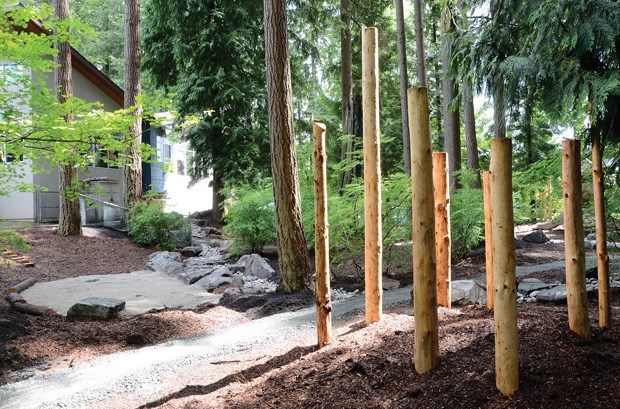Of all things in life, perhaps the most important is our hope for a bright future for our children.
I recently found some hope at a special place; but, this story is not just about hope, it's about changing the status quo.
You see, there's a change happening in childcare, and it's changing the paradigm of play. Slowly passing are the days of over-priced, expensive aluminum and plastic playgrounds that come with large, empty safety zones, rubber fall protection mats and the liability-free version of recreation. Today's educators are yearning for play spaces that involve experiential learning through physical interaction with the natural world.
Tucked under the forest at the Capilano University Children's Centre are some passionate and caring people who won't let the status quo keep them from pursuing their dream. They're choosing a better way to guide the physical, intellectual and emotional development of children under the age of five. I first spoke with Jennifer Wilson, manager of development and alumni services for Capilano University.
Her passion and optimism was welcoming. "The families at the children's centre are consulted to get their feedback," she told me. "Through the parents and our staff, we are looking to build community, further the development of early childcare understanding and to create an enriching playlearn space for the children."
Many people were involved in the development of the new nature-inspired learning space, but two visionaries stood out during my interview, including Sylvia Kind, an artist and teacher at Capilano University who specializes in the role of artists in early childhood development. Two of her photographs of children learning and playing made a profound impact on me that continues to resonate. The other was Tia Smith, manager of childcare services. She has been teaching for 10 years.
"The well-being of children and families is a responsibility we share not just within communities but also globally," she said. Smith is particularly interested in addressing the significance of the first three years in a young child's life.
An interesting synergy has been created between the children's centre and Capilano University's diploma and degree programs in early childhood care and education. Those programs provide practicum learning at the campus daycare centre. I am a strong supporter of practicum training because it facilitates the practical application of theoretical information to help realize the educational benefit to society.
The nature-inspired learning space was made possible by the gracious support of the O'Neill family, which donated $50,000 to build a place for children to play. Houston Landscapes, the project's construction contractor, also donated $3,000 to the project. However, another $50,000 is needed to complete construction and help realize the full potential of this unique play and learn space. (If you're interested in making a donation to the Capilano University Children's Centre, contact Smith at 604-984-4950 or [email protected]).
The first phase of the project, designed by Ron Rule Consultants, is now being built and includes preservation of the large West Coast conifers that grace the site, provide shade and create a sense of place. Also under construction is a dry stream bed, some teepeelike log structures, space for sand, logs and more of the challenging natural world that is intended to stimulate early childhood physical and mental development.
I asked Smith what's different about Capilano University's child care educators? "We watch how the children move," she said.
"How they learn the rhythm of the day or the season. We help young children learn about those rhythms and their own rhythms in relation to the world around them."
During my visit, I walked with Smith and Wilson through the daycare's rooms until I came upon a room with large windows overlooking the forested play-learn space under construction. In the room stood an eight-foot tall bundle of small tree stems tied into the form of a teepee. I remarked to one of the teachers that it was an interesting teepee.
"It's a structure," she said.
I looked at her, puzzled, and she continued, "It's a space ship, castle or whatever the kids want it to be."
Her point continues to resonate with me. Her comment and the general demeanor of the children seemed positive and upbeat.
At one point, while I was in the office speaking with Smith and Wilson, three young girls came up to its half window, lined up their happy little faces so only their hair, eyes and noses were visible, and peeked in to see what we were doing.
In other places, the kids might have been shuffled away to avoid disturbance, but in this place, things are more open to inspiration.
It was a learning experience and a precious moment. Those moments symbolized the playfulness and learning-inspired philosophy of the people caring for our youngest children.
Todd Major is a journeyman horticulturist, garden designer and builder, teacher and organic advocate. [email protected]



